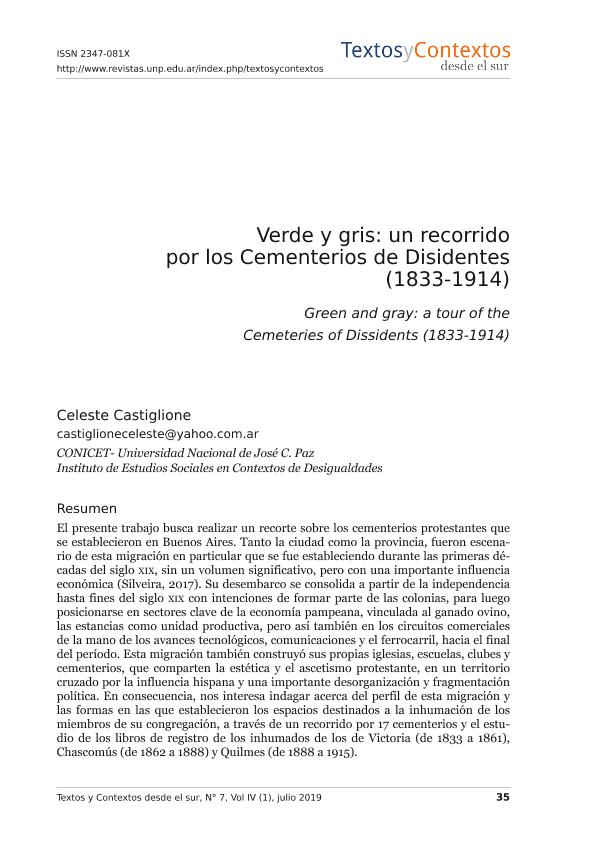Mostrar el registro sencillo del ítem
dc.contributor.author
Castiglione, María Celeste

dc.date.available
2021-07-02T18:08:22Z
dc.date.issued
2019-07-31
dc.identifier.citation
Castiglione, María Celeste; Verde y gris: Un recorrido por los cementerios de disidentes (1833-1914); Universidad Nacional de la Patagonia San Juan Bosco; Textos y Contextos desde el Sur; 4; 7; 31-7-2019; 35-55
dc.identifier.issn
2347-081X
dc.identifier.uri
http://hdl.handle.net/11336/135447
dc.description.abstract
El presente trabajo busca realizar un recorte sobre los cementerios protestantes que se establecieron en Buenos Aires. Tanto la ciudad como la provincia, fueron escenario de esta migración en particular que se fue estableciendo durante las primeras décadas del siglo XIX, sin un volumen significativo, pero con una importante influencia económica (Silveira, 2017). Su desembarco se consolida a partir de la independencia hasta fines del siglo XIX con intenciones de formar parte de las colonias, para luego posicionarse en sectores clave de la economía pampeana, vinculada al ganado ovino, las estancias como unidad productiva, pero así también en los circuitos comerciales de la mano de los avances tecnológicos, comunicaciones y el ferrocarril, hacia el final del período. Esta migración también construyó sus propias iglesias, escuelas, clubes y cementerios, que comparten la estética y el ascetismo protestante, en un territorio cruzado por la influencia hispana y una importante desorganización y fragmentación política. En consecuencia, nos interesa indagar acerca del perfil de esta migración y las formas en las que establecieron los espacios destinados a la inhumación de los miembros de su congregación, a través de un recorrido por 17 cementerios y el estudio de los libros de registro de los inhumados de los de Victoria (de 1833 a 1861), Chascomús (de 1862 a 1888) y Quilmes (de 1888 a 191
dc.description.abstract
The present work seeks to make a cut on the Protestant cemeteries that were established in Buenos Aires. Both the city and the province were the scene of this particular migration that was established during the nineteenth century, without a significant volume, but with an important economic influence. Their landing consolidated from independence until the end of the nineteenth century with the intention of forming part of the colonies, to later position themselves in key sectors of the Pampean economy, linked to sheep, ranches as a productive unit, but also in the commercial circuits hand in hand with technological advances, communications and the railway, towards the end of the period. This migration also built its own churches, schools, clubs and cemeteries, which share the aesthetics and Protestant asceticism, in a territory crossed by Hispanic influence and an important disorganization and political fragmentation. Consequently, we are interested in inquiring about the profile of this migration and the ways in which it established the spaces destined for the burial of the members of its congregation, through a tour of 17 cemeteries and the study of the registry books of the inhumados of those of Victory (of 1833 to 1861), Chascomús (of 1862 to 1888) and Quilmes (of 1888 to 1915)
dc.format
application/pdf
dc.language.iso
spa
dc.publisher
Universidad Nacional de la Patagonia San Juan Bosco

dc.rights
info:eu-repo/semantics/openAccess
dc.rights.uri
https://creativecommons.org/licenses/by-nc/2.5/ar/
dc.subject
MIGRACIONES TEMPRANAS
dc.subject
CEMENTERIOS DE DISIDENTES
dc.subject
SIGLO XIX
dc.subject
BUENOS AIRES
dc.subject.classification
Tópicos Sociales

dc.subject.classification
Sociología

dc.subject.classification
CIENCIAS SOCIALES

dc.title
Verde y gris: Un recorrido por los cementerios de disidentes (1833-1914)
dc.title
Green and grey: A tour of the cemeteries of dissidents (1833-1914)
dc.type
info:eu-repo/semantics/article
dc.type
info:ar-repo/semantics/artículo
dc.type
info:eu-repo/semantics/publishedVersion
dc.date.updated
2021-06-30T16:47:02Z
dc.journal.volume
4
dc.journal.number
7
dc.journal.pagination
35-55
dc.journal.pais
Argentina

dc.journal.ciudad
Comodoro Rivadavia
dc.description.fil
Fil: Castiglione, María Celeste. Universidad Nacional de José Clemente Paz. Instituto de Estudios Sociales en Contextos de Desigualdades; Argentina. Consejo Nacional de Investigaciones Científicas y Técnicas; Argentina
dc.journal.title
Textos y Contextos desde el Sur
dc.relation.alternativeid
info:eu-repo/semantics/altIdentifier/url/http://www.revistas.unp.edu.ar/index.php/textosycontextos/article/view/61
Archivos asociados
